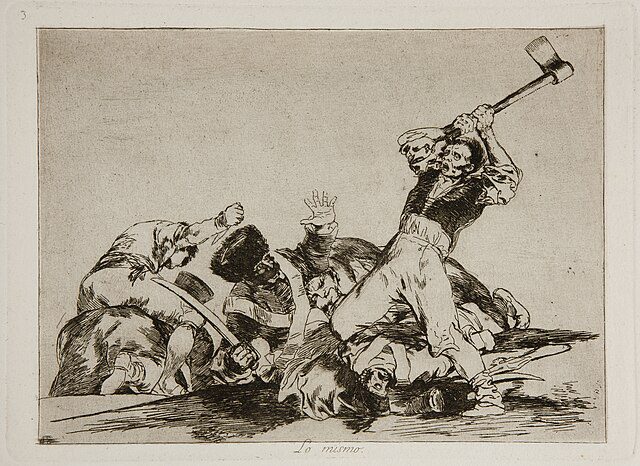
Art has always been a mirror reflecting the myriad facets of human existence, from the serene to the horrific. In the modern era, where terrorism has become a grim reality, art’s role as a social and political commentator has never been more crucial. The way artists respond to terrorism—whether advocating for peace, inciting conflict, or prompting reflection—sheds light on the multifaceted impacts of such violence on society.
Historical Context
Throughout history, art has depicted the brutality and heroism of war. Francisco Goya’s “The Disasters of War” series from the early 19th century provides a stark portrayal of the horrors of conflict. Goya’s works, filled with anguish and despair, convey the senseless suffering caused by war, setting a precedent for future artists to follow.
Art has also served as a tool for propaganda. During World War II, both the Allies and the Axis powers employed art to boost morale and demonize the enemy. Posters, films, and even cartoons played a pivotal role in shaping public perception and garnering support for the war effort. The powerful imagery and emotive messages of these works were designed to influence public sentiment and national morale.
The Vietnam War era saw a shift, with many artists turning to anti-war themes. Photographs like Nick Ut’s “Napalm Girl” shocked the world and fueled anti-war sentiment. This era underscored how art could challenge official narratives and galvanize public opposition to conflict.
Art as a Voice for Peace
Art has long been a medium for advocating peace. Pablo Picasso’s “Guernica,” painted in response to the bombing of the Spanish town during the Spanish Civil War, remains one of the most powerful anti-war statements in art history. The mural’s chaotic composition and haunting imagery convey the tragedies of war and the suffering of innocent civilians.
Contemporary artists continue this tradition. Banksy, the elusive street artist, uses his work to comment on modern conflicts and advocate for peace. His pieces often juxtapose innocent imagery with violent scenes, creating a stark commentary on the absurdity of war. One of his notable works, “Girl with a Balloon,” reimagined in various conflict zones, symbolizes hope amidst chaos.
Ai Weiwei, a Chinese contemporary artist and activist, also uses his art to speak against violence and repression. His installation “Remembering,” made up of thousands of backpacks representing children lost in the 2008 Sichuan earthquake, criticizes the Chinese government’s response to the disaster. Ai’s work emphasizes the human cost of political negligence and violence.
These artists use symbolism and powerful imagery to convey their messages. Through their work, they strive to inspire change, promote dialogue, and remind us of the value of peace and human life.
Art as a Catalyst for War
However, art is not always a force for peace. Throughout history, it has been used to incite violence and rally people to conflict. Propaganda art during wartime often glorifies battle and demonizes the enemy, fostering a climate of fear and aggression. The Soviet Union, for instance, produced numerous posters depicting their enemies as monstrous and their soldiers as heroic, thus justifying their actions and rallying support.
Nationalistic art can also stoke the flames of war. During the rise of fascism in Europe, artists were commissioned to create works that promoted national pride and militarism. These pieces often depicted the nation’s enemies in a dehumanizing manner, reinforcing the justifications for war and violence. This type of art plays on people’s fears and prejudices, making it easier to mobilize them for conflict.
In more recent times, propaganda art continues to emerge in regions plagued by terrorism. In the Middle East, militant groups have used art and media to recruit and radicalize individuals. These works often glorify martyrdom and depict violence as a noble cause, perpetuating cycles of conflict and hatred.
Such art demonstrates the dual nature of creative expression. While it has the power to heal and unite, it can also be weaponized to incite violence and division, reflecting the darker aspects of human society.
The Dual Role of Art in the Age of Terrorism
In the age of terrorism, art serves both as a reflection of the horror and a tool for promoting dialogue. Artists today grapple with the complexities of terrorism, depicting its brutal realities while also seeking pathways to peace. Their works often serve as a form of catharsis, helping societies process and understand the trauma of terrorism.
Modern artists have created poignant works that capture the impact of terrorism. Following the 9/11 attacks, many artists produced pieces that reflected the shock, grief, and resilience of those affected. The photograph “The Falling Man,” by Richard Drew, captures the harrowing moment of an individual’s free fall from the World Trade Center, encapsulating the human cost of the tragedy.
In the Middle East, artists have responded to ongoing violence with works that both critique and mourn. Syrian artist Tammam Azzam gained international attention with his digital artwork “Freedom Graffiti,” which superimposed Gustav Klimt’s “The Kiss” onto a war-torn building in Syria. This piece contrasts the beauty of art with the devastation of conflict, emphasizing the enduring power of love and humanity.
Art can also promote dialogue and understanding. Projects that bring together artists from conflicting regions aim to foster empathy and communication. These initiatives use art as a bridge, connecting individuals through shared creative expression and highlighting common human experiences.
Notable Works and Artists
Several artists stand out for their contributions to the conversation on terrorism and peace. Gerhard Richter, a German visual artist, has addressed themes of terrorism in his work. His painting “September” captures the haunting memory of the 9/11 attacks, blending abstraction with a realistic depiction of the event, conveying the lingering impact of that day.
Another significant artist is Doris Salcedo, a Colombian sculptor whose work often addresses themes of violence and loss. Her installation “Shibboleth” at the Tate Modern in London featured a deep crack in the museum’s floor, symbolizing the divisions caused by racism, terrorism, and conflict. Salcedo’s work invites viewers to confront these uncomfortable realities and consider paths to reconciliation.
In photography, the work of James Nachtwey stands out. Nachtwey has documented conflicts around the world, capturing the raw and often brutal realities of war and terrorism. His photographs serve as a powerful reminder of the human suffering caused by violence and the urgent need for peace.
These artists, through their diverse mediums and perspectives, contribute to a broader understanding of terrorism’s impact and the possibilities for peace.
Public Reception and Critique
The reception of art about terrorism varies widely. Audiences often have strong, visceral reactions to such works, reflecting the deeply emotional nature of the subject matter. Some pieces are praised for their courage and honesty, while others are criticized for being provocative or insensitive.
Controversies are not uncommon. For example, the “Piss Christ” photograph by Andres Serrano, which depicted a crucifix submerged in urine, faced significant backlash and was seen by some as a provocative critique of religion and violence. Similarly, exhibits that feature graphic depictions of terrorism can provoke strong reactions, sometimes leading to censorship or public outcry.
In authoritarian regimes, art about terrorism is often heavily censored. Artists who criticize their governments or highlight the impact of state-sponsored violence risk persecution. This censorship stifles important conversations and prevents societies from fully grappling with their issues.
Despite these challenges, many artists continue to push boundaries and challenge audiences. Their work prompts essential dialogues about the nature of terrorism, the impact of violence, and the pathways to peace.
The Future of Art in a Terror-Ridden World
Looking ahead, the role of art in addressing terrorism will likely continue to evolve. Emerging trends suggest that future artists will increasingly use digital media and technology to explore these themes. Virtual reality, for instance, offers immersive experiences that can bring viewers closer to the realities of conflict and terrorism.
Social media platforms have also become crucial for contemporary artists. These platforms allow for rapid dissemination of artwork and provide a space for artists to engage with global audiences directly. This accessibility can amplify messages of peace and facilitate broader conversations about terrorism.
Art education plays a crucial role in shaping future generations’ understanding of terrorism and peace. By integrating discussions about these themes into art curricula, educators can foster critical thinking and empathy in young artists. This approach can help cultivate a more peaceful and reflective society.
Art in the age of terrorism serves as both a voice for peace and a catalyst for war. It reflects the horrors of conflict, promotes dialogue, and fosters understanding. At the same time, it can be used to incite violence and perpetuate division. The dual role of art underscores its power and the responsibility of artists to navigate these complex themes thoughtfully.
As we move forward, the enduring words of Martin Luther King Jr. resonate deeply: “Darkness cannot drive out darkness; only light can do that. Hate cannot drive out hate; only love can do that.” Art, in its many forms, has the potential to be that light, guiding us toward a more peaceful world.




